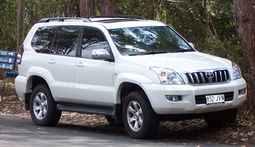The History Of Toyota LAND Cruiser Prado

Toyota Land Cruiser Prado is a model designation used in Japan, Australia, South Africa, Middle East, Southeast Asia and Latin America as well as other parts of the world for light-duty, mid-sized four-wheel drive cars in the Toyota Land Cruiser line. They are produced by the Japanese car maker Toyota Motor Corporation. The car is marketed in many other parts of the developing world, such as the Caribbean and large parts of Africa.
In Europe it is sold as simply Toyota Land Cruiser, or with the number series designation (LC 70, LC 90 and LC 120). In North America it is not part of the Land Cruiser range, being instead sold as the Lexus GX 470, with nearly identical body panels and a V8 engine.
The current Prado is based on Toyota's J12 platform. Previous models were based on the J9 and J7 platforms. All models designated Prado feature front independent suspension, ladder frame, and a two-speed transfer case.
The Toyota Land Cruiser Prado is available in GX, GXL and VX spec versions, with either short or long wheel base. The GX is the entry level model, while the VX is the more luxurious version. In most markets it is available with either a 4.0L petrol V6 and a 3.0L Diesel engine. In some European countries there are commercial van variants, based on the short wheel base chassis.
First (Land Cruiser 70-Light series / Bundera model: 1984 to 1990)
First developed as the light duty of the 70 Series, in November 1984. Available only in short body, and there were options for soft top or hard top (metal top). Names like Land Cruiser II, Land Cruiser, and Bundera were made for these 'Light Duty' Land Cruisers. There were 3 engines options with gasoline engines, 2.4 L (2366cc) 22R engines and 2.4L (2446cc) 2L and 2L-T diesel engines. Transmission for the gasoline engine is G52 type while the diesel used the R150 and R151 type. These were the same engines and transmission used in 4Runner, in cooperation with Hino.
First (Land Cruiser 70-series Prado model: 1990 to 1996)
By April 1990, a new type was developed. The front grille, front fender and engine hood were redesigned. The head lamp went through changes in design as well. At the same time, the sub name Prado were attached, but names like Land Cruiser and Land Cruiser II were still in used in other parts of the country besides Japan. Meaning plain or field in Portuguese, Prado is the new line from Land Cruiser suited more for on-road purposes, though it is also a highly capable off-road vehicle. Created as Super Hybrid 4WD, it comes with electronic fuel injection and 4 speed automatic transmission. The 2.4L diesel engine with 97metric horsepower (71kW) and 24.5kg·m (240N·m; 177ft·lbf) high torque unit was installed into it. The line ups are 2-door and 4-door version named LX5 and SX5, and only the 4 door with the highest class named EX5.
Coil springs was also upgraded, the SX5 and EX5 grade can switch between stages of absorber with a touch of a button. The gasoline engines 22R were replaced by 22R-E and diesel engines were replaced by 2.8L (2776cc), 3L engines and 2.4 L (2446cc) 2L-T were replaced by a new developed 2L-TE engines. By 1993, 22R-E gasoline engines were replaced by 2.7L (2693cc) 3RZ-FE and 2L-TE turbo diesel engines were replaced by aluminium cylinder head 3.0L (2982cc) 1KZ-TE along with some minor changes at the body. The 1KZ-TE was able to reduce NOx and soot. The suspension and brake was also upgraded. The 70-series Prado was replaced by the 90-series Prado in 1996.
Second (Land Cruiser 90-series Prado model: 1996 to 2002)
In May 1996, the 70-series underwent a makeover and emerged as the 90-series Prado, an independent series. The body was enlarged in and out. The design was heavy-duty, like the 70-series Prado, but with a smaller engine and lighter classification compared to the full-sized Land Cruiser series. Although new in designs, the suspension is similar to those used in Tacoma and Hilux Surf made by Hino.
The 3-door series starts with an R in the series ranging from RZ, RX, RS to RJ while the 5-door line-up starts with T in the series ranging from TZ, TX, TS, to TJ. All models comes with model front double wishbone and 4 linked suspension as well as full-time 4WD. ABS and Field Monitor showing altimeter, termometer and pressure was standard in all the models. Television display and audio set was also optional.
Gasoline engines include 2.7L (2693cc) 3RZ-FE and, new in Prado models, 3.4L (3378cc) V6 5VZ-FE. Diesel engines are 2.8L (2776cc) 3L engine, 3.0L (2986cc) 5L engine and 3.0L (2982cc) 1KZ-TE.
By June 1999, minor changes were made. In order to follow the new law, fog-lamps were attached to the bumper. In July 2000, a new developed diesel engine, 3.0 L (2982cc) Common Rail Diesel Injection (D-4D) 1KD-FTV was introduced into this model. With the 1KD-FTV engine, Prado can finally be on par with the Land Cruiser series when it comes to power. In order to avoid thievery, engine immobilizer was available. TX Limited with 8 seats used TX base with roof rail, rear under mirror, wood panel finish, arm rest, optitron meter, base cooling as well as rear heater was introduced into this series. The 90-series Prado was replaced by the 120-series Prado in 2003.
UK Sales
When the Prado was launched in the UK in 1996, it was called the Land Cruiser Colorado and replaced the 4Runner, which had been discontinued from sale. It was called this to distinguish it from the larger Land Cruiser - renamed as the Land Cruiser Amazon - which was already on sale.
It dropped the Colorado name tag in 2003, when it was renamed simply Land Cruiser.
Third (Land Cruiser 120-series Prado model: 2003 till present)
First appeared in 2003, this is the newest model of Land Cruiser Prado group. This model no longer follow its predecessors title known as the 'light duty' Land Cruiser but rather as a mid-sized luxury-type SUV. A new 4.0L (3955cc) V6 1GR-FE gasoline engine was available only in Europe first.
Engines available are the 2.7L (2693cc) straight-4 3RZ-FE, 3.4 L (3378cc) V-6 5VZ-FE and 3.0 L (2982cc) straight-4 Turbo diesel 1KD-FTV. In countries like China, a newly developed engine 1GR-FE V6 is available. Because the 120-series is a luxury-type SUV in some markets, burglary is not uncommon. For this purpose, the immoblizer is introduced into this model.
In August 2004, the 3RZ-FE was replaced by 2.7L (2694cc) 2TR-FE and in July 2005, 5VZ-FE was replaced by 4.0L (3955cc) V6 1GR-FE with 5-speed automatic transmission available in late 2005. In countries like America, this model is known as Lexus GX 470 with 4.7L (4663cc) V8 2UZ-FE engine.
Diesel models have had the 1KZ-TE turbo diesel engine with maximum output rating 131PS (96kW) as well as the 5L-E natural aspirated diesel engine rating 95PS (70kW) . In November 2006, Toyota introduced the 1KD-FTV Turbo Diesel (D-4D] engine to meet Euro IV emission standards. This engine delivers 173PS (127kW) of power and 410Nm of torque. The upgrade to the D-4D engine was also matched with transmission upgrades to the diesel range, with the 5-speed automatic and 6-speed manual transmissions added in line with the petrol powered range. From August 2007 the Prado received several equipment and safety upgrades.
The 120-series Land Cruiser Prado shares the same suspension parts as the current generation Hi-Lux Surf/ 4Runner and FJ Cruiser.
A similar SUV manufactured in China, the Dadi Shuttle, has near identical front end styling to the Prado, but it is not a badge-engineered Land Cruiser Prado.
From Wikipedia, the free encyclopedia
More About Toyota LAND Cruiser Prado






|